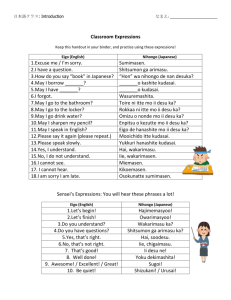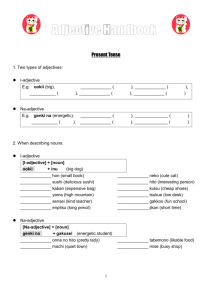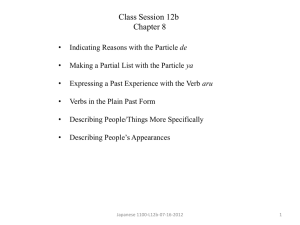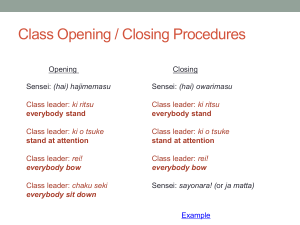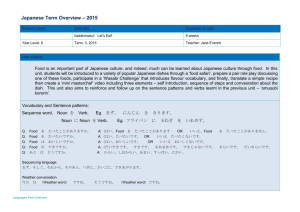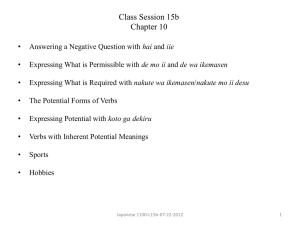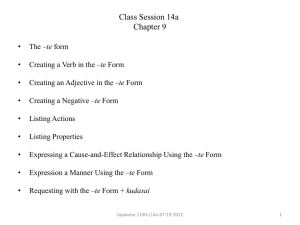Lesson 1: Language Notes and Grammar L.1 Greetings Ohayou
advertisement
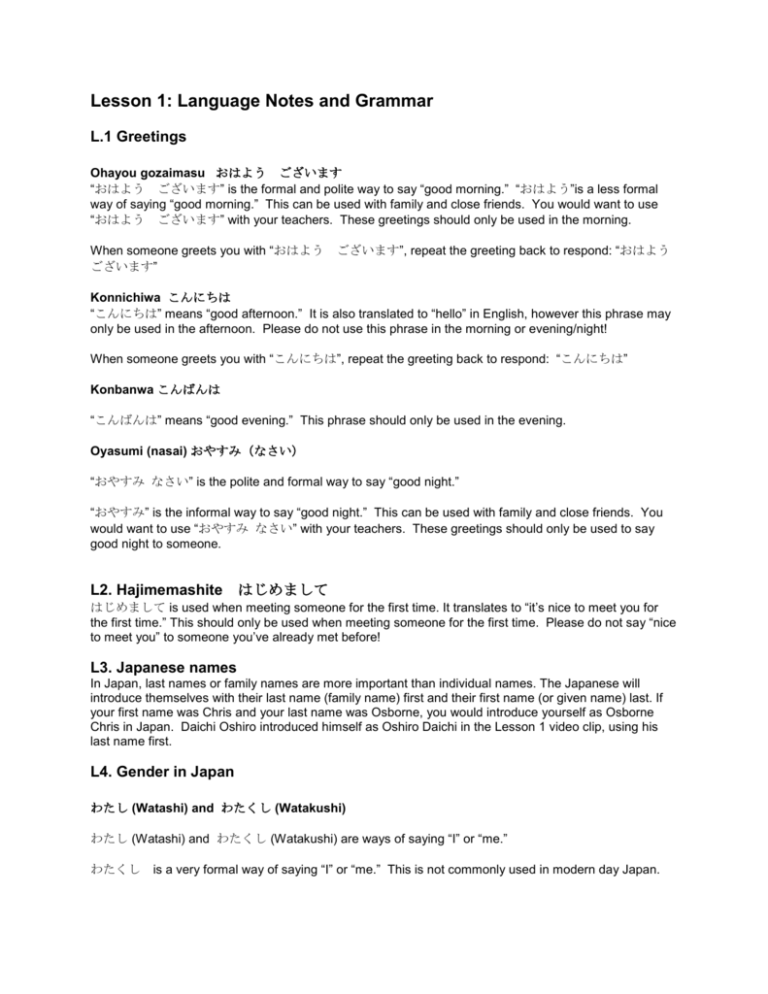
Lesson 1: Language Notes and Grammar L.1 Greetings Ohayou gozaimasu おはよう ございます “おはよう ございます” is the formal and polite way to say “good morning.” “おはよう”is a less formal way of saying “good morning.” This can be used with family and close friends. You would want to use “おはよう ございます” with your teachers. These greetings should only be used in the morning. When someone greets you with “おはよう ございます” ございます”, repeat the greeting back to respond: “おはよう Konnichiwa こんにちは “こんにちは” means “good afternoon.” It is also translated to “hello” in English, however this phrase may only be used in the afternoon. Please do not use this phrase in the morning or evening/night! When someone greets you with “こんにちは”, repeat the greeting back to respond: “こんにちは” Konbanwa こんばんは “こんばんは” means “good evening.” This phrase should only be used in the evening. Oyasumi (nasai) おやすみ(なさい) “おやすみ なさい” is the polite and formal way to say “good night.” “おやすみ” is the informal way to say “good night.” This can be used with family and close friends. You would want to use “おやすみ なさい” with your teachers. These greetings should only be used to say good night to someone. L2. Hajimemashite はじめまして はじめまして is used when meeting someone for the first time. It translates to “it’s nice to meet you for the first time.” This should only be used when meeting someone for the first time. Please do not say “nice to meet you” to someone you’ve already met before! L3. Japanese names In Japan, last names or family names are more important than individual names. The Japanese will introduce themselves with their last name (family name) first and their first name (or given name) last. If your first name was Chris and your last name was Osborne, you would introduce yourself as Osborne Chris in Japan. Daichi Oshiro introduced himself as Oshiro Daichi in the Lesson 1 video clip, using his last name first. L4. Gender in Japan わたし (Watashi) and わたくし (Watakushi) わたし (Watashi) and わたくし (Watakushi) are ways of saying “I” or “me.” わたくし is a very formal way of saying “I” or “me.” This is not commonly used in modern day Japan. わたし Boku is more commonly used to say “I” or “me.” This can be used by men or women. ぼく ぼく (boku) also translates to “I” or “me,” but this word is reserved for men. Ladies, please do not use ぼく to say “I” or “me.” L5. douzo yoroshiku どうぞ よろしく The phrase どうぞよろしく can be translated “please treat me kindly”. You can use this phrase when you meet someone for the first time. It implies that you probably will have dealings with the person you just have met. Hence you can also use this with a person. L6. Using お (o) in front of words Using お in front of words or phrases makes them more polite and formal. For example: おげんき ですか。 ogenki desu ka. How are you? おすし osushi sushi おなまえ onamae name Using o in front of a word or praise to make it more polite/formal is optional. You may see the お “o” written in brackets like this in your course material: (お) This is only to illustrate that the お “o” is optional. If you write the お "o" in front of the word, do not write the brackets ( ). The brackets are used to help you understand the "o" in front of the word is optional and makes it more polite and formal. For example: おすし osushi = correct! (お)すし (o)sushi = incorrect! L7. san さん さん (san) translates to: Mr./Mrs./Ms./Miss. さん is used for both men and women. It goes at the end of the name. For example: だいち さん (Daichi san) なかむら さん (Nakamura san) さん is used after someone’s name to be more polite and formal. さん cannot be used after your own name or a family member’s name. GRAMMAR NOTES―ぶんぽう G1. The verb です(Desu) です is a verb that means “is/am/are.” The last u in “desu” is silent and the word sounds like “des” when pronounced. In Japanese, verbs are placed at the end of sentences. Here are some example sentences that use the verb です: わたし は さくら です。 Watashi wa Sakura desu. I am Sakura. わたし の なまえ は さくら です。 Watashi no namae wa Sakura desu. My name is Sakura. わたし は ちゅうがくせい です。 Watashi wa chuugakusei desu. I am a middle school student. G2. Sentence structure in Japanese compared to English. In the English language, the sentence structure order is Subject Verb Object. In the sentence: “I am Daichi.” the subject is I, the verb is am and the object is Daichi, so we put them in that order. (Subject, Object, Verb) In the sentence: “I eat sushi.” the subject is I, the verb is eat and the object is sushi. This sentence also uses the subject, object and verb format. In Japanese, the sentence structure order is Subject Object Verb. The subject comes first and the object will come after the subject. Verbs are found at the end of sentences. For example: わたし は だいち です。 Watashi wa Daichi desu. In this sentence, we’re literally saying: “I Daichi am.” The subject (わたし) is first, the object (だいち) comes after the subject and the verb (です) is found at the end of the sentence. わたし は すし を たべます。 Watashi wa sushi o tabemasu. Here, we’re literally saying: “I sushi eat.” This sentence also uses the subject, object, verb syntax. This is how sentences are made in Japanese. G3. Particles じょし The Japanese language uses particles. Particles connect nouns, verbs, adjectives, and adverbs in sentences. Particles are not used in English, but in Japanese they are used to connect words. In the sentence below, the particle は is connects the topic (subject) and the object. わたし は だいち です。 Watashi wa Daichi desu. I Daichi am. Wa は (particle) Rule 1: は is the hiragana character for “ha” but when it is written as a particle it is pronounced as “wa.” は is used after a noun which marks the topic of a sentence. わたし は さくら です。 Watashi wa Sakura desu. I am Sakura. Remember to use the particle は after the subject. わたし ___ だいち です。 Watashi Daichi desu. = incorrect! わたし は です。 Watashi wa Daichi desu. = correct! だいち Rule 2: は: When the predicate of a question is clear for both the speaker and the listener, you can use an abbreviated version of the sentence. は still functions as “topic particle”, and the rest of the sentence can be omitted. You can use this when you want to say “how about so and so?” or repeat the question that was previously asked. This form is used mainly in speaking, not writing. Example 1: Daichi: さくら さん、 おげんきですか。 Sakurasan o genki desu ka. How are you Sakura? Sakura: はい げんき です。だいちさん Hai genki desu. Daichi san wa. I’m fine. How about you Daichi? は。 Sakura can simply use は after Daichi’s name to ask how he is instead of asking “おげんきですか。” because he already asked her the same question. Instead of asking Daichi with a complete sentence, Sakura shortened her sentence and basically asked “How about you, Daichi?” by using だいちさん は。 Example 2: Daichi: ぼくは だいち です。おなまえ は。 Boku wa Daichi desu. Onamae wa. I am Daichi. What is your name? Sakura: わたし は さくら です。 watashi wa Sakura desu. I am Sakura. In this conversation, Daichi introduced himself to Sakura. Sakura understood that Daichi asked for her name even though the sentence was shortened with は. After stating his name (Daichi’s), he asked Sakura’s name was. G3. ka か (particle) The particle か is used at the end of a sentence to make it a question. It is similar to the question mark. For example: (お)げんき ですか。 (o)genki desu ka. How are you? なん ねん せい ですか。 Nan nen sei desu ka. What grade are you in? (お)なまえ は なん ですか。 (o)namae wa nan desu ka. What is your name?
